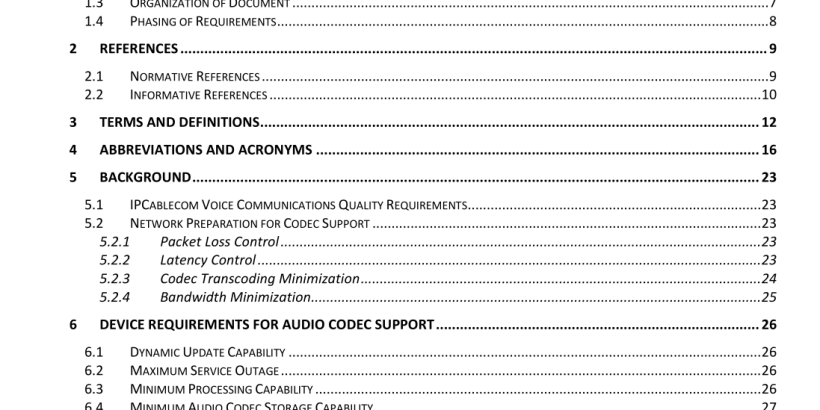ANSI SCTE 165-2-2016 pdf download. Audio/Video Codecs
1 SCOPE
This document addresses interfaces between IPCablecom client devices for audio and video communication. Specifically, it identifies the audio and video codecs necessary to provide the highest quality and the most resource- efficient service delivery to the customer. This document also specifies the performance required in client devices to support future IPCablecom codecs. Additionally, this document describes a suggested methodology for optimal network support for codecs.
1.1 Introduction and Overview
The quality of audio and video delivered over the IPCablecom architecture will depend on multiple factors: the end device performance, the network’s inherent quality, and the intelligence of the system resource allocation policy. This document defines mandated codecs and capabilities supporting audio and video applications, with a particular emphasis on the stringent requirements of IP-based voice communications. Acceptable voice communications functionality imposes strict latency and packet-loss criteria on IP implementations and will thus stress system resources, particularly if bandwidth becomes congested or saturated. Video applications — while more forgiving to dropped packets and latency — require bandwidth of at least an order of magnitude more than audio applications. The IPCablecom architecture is designed to support both types of applications simultaneously. Speech and video compression are evolving technologies. New algorithms are being enabled as more sophisticated and higher performing processors become available at lower cost. Additionally, the system infrastructure and mechanisms for allocating resources will evolve. Due to this dynamism, the priority in designing the architecture is to define a robust system to accommodate evolving technology without creating a legacy burden. Therefore, the IPCablecom philosophy is to establish cost-effective envelopes for network and device performance to enable the most appropriate current technology, while allowing upgrades as technology and market needs evolve. To address near-term market needs, this document also specifies codec and performance mandates to deliver the quality-of-service necessary for launching competitive services.
1.2 Purpose of the Document
The purpose of this document is to extend the existing IPCablecom 1.0 Codec specification by introducing two new low-bit codecs, ITU-T T.38 fax relay for reliable fax transmission, IETF RFC 2833 DTMF Relay for reliable DTMF transmission, and metrics to measure voice quality. It is issued to facilitate design and field-testing leading to the manufacturability and interoperability of conforming hardware and software by multiple vendors.
The legal/regulatory classification of IP-based voice communications provided over cable networks and otherwise, and the legal/regulatory obligations, if any, borne by providers of such voice communications, are not yet fully defined by appropriate legal and regulatory authorities. Nothing in this specification is addressed to, or intended to affect, those issues. In particular, while this document uses standard terms such as “call,” “call signaling,” “telephony,” etc., it will be evident from this document that while a IPCablecom network performs activities analogous to these PSTN functions, the manner by which it does so differs considerably from the manner in which they are performed in the PSTN by telecommunications carriers. These differences may be significant for legal/regulatory purposes.
5 BACKGROUND
This section outlines the IPCablecom architecture support elements and the DOCSIS ® network infrastructure necessary to deliver quality audio and video service. It is intended to clarify external interfaces and functional requirements necessary to implement the targeted audio and video quality using speech and video codecs. The key requirement for voice communications using IP transmission is the ability to attain “toll” or better audio quality. Given the variable nature of shared packet mediums and the stringent human-factor requirements of this quality standard, it is necessary to optimize multiple system parameters to attain this goal. Additionally, IPCablecom has been tasked with offering superior quality, exceeding current PSTN standards where feasible. Key requirements from the IPCablecom product definition requiring architectural optimization for codecs follow.ANSI SCTE 165-2-2016 pdf download
